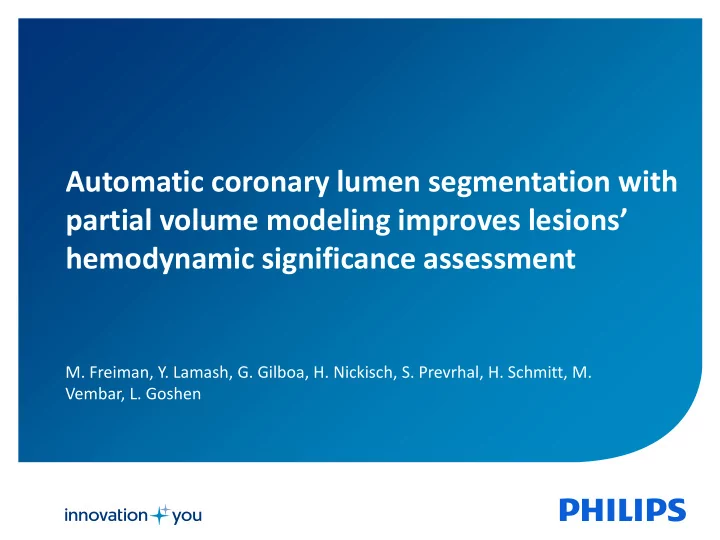

Automatic coronary lumen segmentation with partial volume modeling improves lesions’ hemodynamic significance assessment M. Freiman, Y. Lamash, G. Gilboa, H. Nickisch, S. Prevrhal, H. Schmitt, M. Vembar, L. Goshen
Coronary Artery Disease Image source: http://www.nhlbi.nih.gov/health/health-topics/topics/cad/signs 2
Clinical motivation: from anatomy to function • Current gold standard for CAD stenting: hemodynamic significant stenosis (i.e. pressure drop (FFR) below 0.8). Image sources: 1. http://westjem.com/case-report/red-flags-in-electrocardiogram-for-emergency-physicians-remembering-wellens-syndrome- and-upright-t-wave-in-v1.html 2. Tonino et al, JACC 2010;55:2816-21 3
CCTA for Coronary Artery Disease • Coronary CTA has a high sensitivity and high negative predictive value for diagnosis of obstructive CAD by detecting anatomical narrowing in the coronaries 4
Anatomical assessment of lesion’s significance with CCTA is not enough • CCTA is currently limited to anatomical information about luminal narrowing in the coronaries >50% of lesions with greater than 50% diameter stenosis by CCTA have FFR>0.8 Image source: Meijboom et al. J Am CollCardiol 2008;52:636 – 43 5
Flow simulation enable lesion’s hemodynamic significance assessment from CCTA Vessel by vessel CCTA data Tree extraction segmentation 3D model CFD simulation Goal : to improve CCTA specificity by enabling non-invasive CCTA-based functional hemodynamic characterization of coronary stenosis 6
Key enabler of accurate CCTA flow simulation: Accurate Automatic Coronary lumen segmentation Vessel by vessel ISP CCA Tree extraction segmentation 3D model CFD simulation 7
Partial volume effect on small-radius vessels Small vessel diameters can be overestimated due to the overall system PSF 1 and significantly impact flow simulation results 1. Sato et all, MICCAI 2004 8
Partial volume effect on small-radius vessels Small vessel diameters can be overestimated due to the overall system PSF 1 and significantly impact flow simulation results 1. Sato et all, MICCAI 2004 9
Previous works: MICCAI 2012 workshop Evaluation was limited to anatomical agreement with manual segmentation without assessing impact on flow simulation accuracy Most methods did not consider the PV effect on small vessels diameters 10
Our solution : Automatic coronary segmentation algorithm that accounts for the partial volume effect 𝑭 𝒘 Machine-learning Input: based likelihood + = 𝝔(𝒘) PV detection 𝒘 + 𝝎(𝒘 𝒒 , 𝒘 𝒓 ) 𝒘 𝒒 ,𝒘 𝒓 ∈𝛁 Regularization function F cut B 11
Approximate K nearest neighbor (L2) likelihood estimation Training: Test: 0 0 0 0 1 2 3 , , 4 4 4 4 4 5 5 5 … … 12
Partial Volume detection 13
Partial Volume detection: Algorithm steps Input: Coronary centerline, Coronary centerline intensity profile 1. Robust intensity model fitting: 2. Detection of significant reduction in observed intensity compared to the model: 3. Underlying radius estimation based on pre- calculated model: Output: Adjusted coronary radius at each centerline point after correction for PV 14
Applying PV radius correction on the likelihood map Training: Test: 0 0 0 0 0 0 0 , , 0 0 0 0 1 1 1 1 … … 15
Graph min-cut segmentation (Boykov et al, 2001) • Binary separation of coronaries from the rest (background) formulated as a graph min-cut problem • Minimization of the following energy: • Globally optimal minimization for sub modular functions (edge weights ≥ 0) 16
Experimental setup 85 cardiac CT datasets (389 vessels) + ref. FFR (91 samples) ISP tree extraction ISP manual centerline correction Automatic coronary Automatic coronary segmentation without segmentation with accounting for PVE accounting for PVE FFR-CT simulation FFR-CT simulation Comparison : Flow simulation agreement with invasive FFR 17
Segmentation result: qualitative comparison Without accounting for PVE Blue – Automatic segmentation results without accounting for PVE Red – manual expert segmentation that accounts for PVE 18
Segmentation result: qualitative comparison With accounting for PVE Blue – Automatic segmentation results with accounting for PVE Red – manual expert segmentation that accounts for PVE 19
Experimental results: representative case 20
Experimental results: ROC analysis Accounting for PVE significantly improved the detection performance by means of area under the ROC curve (AUC) by 29% (N=91, 0.85 vs. 0.66, p<0.05). 21
Summary • Functional assessment of coronary lesions based on CCTA and flow simulation requires accurate automatic lumen segmentation • Partial volume effect may cause overestimation of small vessel diameter and reduce flow simulation accuracy • Partial volume effect can be detected by analyzing the intensity profile along the vessel centerline • New graph min-cut based algorithm for accurate coronary lumen segmentation that accounts for potential partial volume effects • Accounting for partial volume in the automatic segmentation yield a substantial improvement in correlation between automatic estimation of FFR from CCTA and invasive FFR measurements 22
Recommend
More recommend